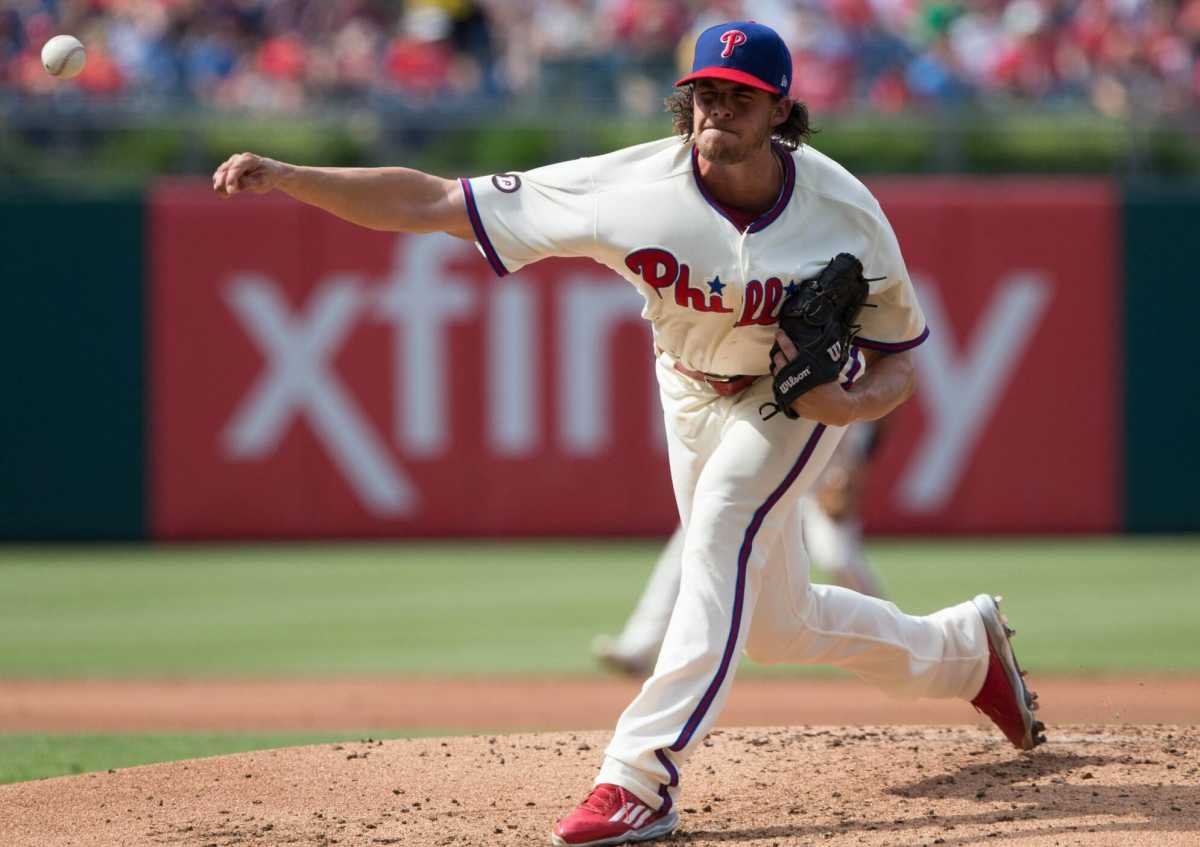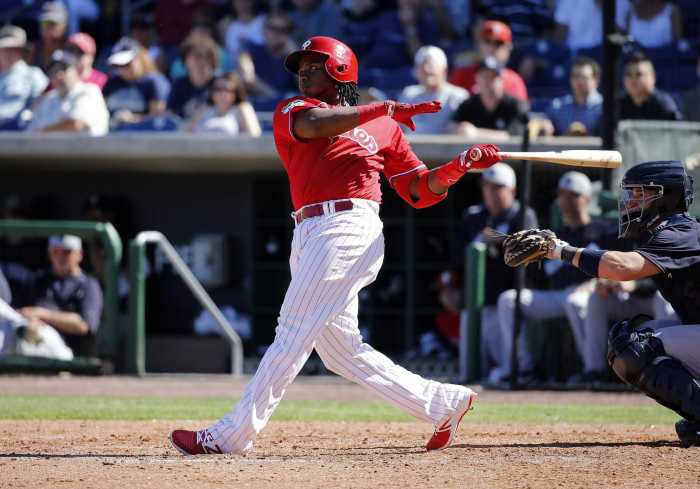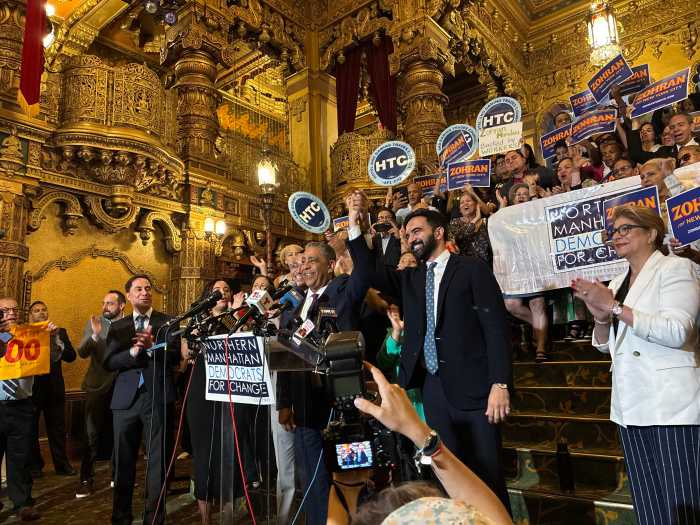Welcome back into this two part piece looking ahead to the 2019 season. I hope you enjoyed Part 1 on the positional players on the Phillies roster.
Should they stay or should they go: Which Phillies remain on the roster in 2019? Part 1
Now, it’s time to get to the pitchers. Just like in Part 1, I’ll break things down by designation, meaning that I’ll break the pitching staff down into starters and relievers. Just like in Part 1, I’ll break down each pitcher on if they’ll still be around on the 25-man roster in two years. The same rules apply for this one; even if I say say “go” for a pitcher, that doesn’t necessarily mean they’ll be out of the organization entirely. They may simply be back down in the minor leagues to make room for another arm. Before we begin, the Phillies demoted Ben Lively this weekend back down to AAA Lehigh Valley to make room on the roster for the return of Jerad Eickhoff. I’ll be putting Lively in this conversation despite him now being back down in the minors because he’s pertinent to the conversation. Also included on this list will be Vince Velasquez and Edubray Ramos, both of whom have had considerable Major League time so far this season.
With that, let’s get started.
Starting Pitchers- Jeremy Hellickson, Aaron Nola, Vince Velasquez, Ben Lively, Nick Pivetta, Jerad Eickhoff, Mark Leiter
Jeremy Hellickson Go:
The Phillies signed Jeremy Hellickson to a one-year deal in 2016 for what many considered a half-season rental. It was rumored up until the July 31 last year that the team would find a trading partner and ship Hellickson for a prospect or two. Except the trade deadline came and went in 2016, and Hellickson was still a Phillie. He pitched well throughout 2016, going 12-10 with a 3.71 ERA, providing some veteran presence on a very young and inconsistent pitching staff. The Phillies rewarded Hellickson with another one-year deal, this time, worth upwards of $17 million. While it was a big salary increase for a guy who was good, but not great last year, the salary cap low Phillies had the money to spend.
We’re now in the exact same situation in 2017, with Hellickson’s name, once again, amidst trade rumors. His ERA is higher this year, and the pull will likely be less than what the tea could have gotten last year, but this summer feels different in that the Phillies are actively seeking a trade destination for Hellickson. I’d expect him to be shipped by the end of the month to a team that is looking to bolster its pitching staff for a stretch run. A team like the Dodgers comes to mind as do the Twins. I’d be shocked to see Hellickson in red pinstripes come August.
Aaron Nola Stay:
Nola looks like he’s finally found his groove and is 100 percent healthy again, which bodes well for the Phillies down the road. The former first round pick out of LSU is currently 6-6 with a 3.59 ERA, but has put together three consecutive starts that has become his best run since his rookie year. In his last five starts, he’s allowed just five runs over 29.1 innings pitched while striking out 34 batters. Despite going eight innings and giving up just two runs on Saturday against the Padres, the offense was ineffective and Nola was tagged with a lose. Before the lose, he had won all three of his previous starts. Nola’s command has also been outstanding recently. Scratch the four walks he surrendered against Seattle on June 27, and you’d have to go back to April 20 to find the last time Nola walked more than two batters in a game. Nola has an awesome team-friendly contract where he is under team control for next season, and isn’t eligible for unrestricted free agency until 2022. If the trend continues of Nola pitching this way, he’ll have been well worth the seventh overall pick in 2014, and he’ll continue to be a very important cog in the Phillies’ rotation for years to come.
Vince Velasquez Stay:
Stay, but not in the role that he’s been in since his Phillies’ debut last year. Velasquez has some of the best stuff I’ve seen in a long time. Yes, the comparisons are there to Nolan Ryan, who struggled for a few years before truly learning how to pitch. We all know how his career turned out: seven no-hitters, over 5000 strikeouts, you know, every day stuff, right? While Velasquez could turn out to project the same as Ryan, I’d actually like to see him take the route of another Hall of Fame pitcher instead, John Smoltz. After 11 years as a starter, John Smoltz was asked to move to the bullpen in 2002 by the Braves and become their closer. His stuff was dominant as a starter, as he posted a sub-3.00 ERA four times over that stretch, but moving to the bullpen allowed him to really unleash. He didn’t have to preserve for seven or eight innings, but instead, could just hurl the ball for one inning each night. I’d like to see Velasquez make that same transition. We’ve seen Velasquez has incredible strikeout success, but far too many times has he only been able to go five or six innings because his pitch count is so high. In 50 innings this season, he has 53 strikeouts, but he’s also started ten games, which means he’s only averaging five innings a start. I’d like to see what he can do firing one inning a night in the closer’s role, where he’d only have to throw 20 pitches at maximum velocity. He has an identical contract to Nola, so the team control is still in place for another season. Velasquez will certainly be on the team in 2019, but a change of role could be highly beneficial to his career and the Phillies’ success.
Ben Lively Go:
As I just mentioned, Lively was sent down to Lehigh Valley to make room for Jared Eickhoff in the rotation. It wasn’t that Lively had pitched poorly, as he was 1-4 but had a 3.80 ERA in eight starts, it’s just that the team believes Eickhoff gives them a better chance to win every fifth day. Lively is not a power pitcher by any means, as he relies heavily on contact to get outs. He’s struckout just 17 hitters in 42.2 innings pitched. That’s not a bad thing by any means, but the Phillies want to see their power arms go to work right now. This season, if the Phillies were to sustain another injury to the rotation, or Hellickson gets traded, Lively would likely be the first arm back up. But I don’t think that’s good enough to salvage his spot on the 2019 roster. There are simply too many arms stacked up in the minor leagues that seem to provide a brighter future than what Lively can provide.
Sixto Sanchez is climbing up the prospect board at an unprecedented rate. He’s currently pitching in Lakewood, but his success could transition into a promotion to Reading to start 2018. That jump from Reading to the big leagues by the 2019 season isn’t too farfetched. Then, of course, there’s Lakewood teammate JoJo Romero and Clearwater righty Franklyn Kilome to think about as well. With all of those arms gearing up for promotions as the next two years march on, Lively seems to be losing a place. I’d like to see him remain a farm arm to provide depth as someone with now Major League experience, but I don’t think Lively factors into the future of the Major League roster like some of the other arms do.
Nick Pivetta Stay:
Despite the inferior stats to Lively in their times with the club, the Phillies chose to keep Pivetta instead of Lively. That means one of two things. Either the team is just working options, Lively’s are more suited to their needs, or they like Pivetta’s stuff better. While Pivetta has a 4.73 ERA, nearly a full point higher than Lively’s, Pivetta’s strikeout numbers, and subsequent stuff, are much better. Pivetta has punched out 62 batters in 59 innings pitched this year. Oddly enough, despite Pivetta’s BAA being .257 to Lively’s .284, Pivett’a WHIP is actually higher at 1.44 to Lively’s 1.38. That means Pivetta’s problem right now is the high walk total. 28 walks in 59 innings pitched will catch up to you eventually.
If he’s able to lower that number and gain better command as his career progresses, I’d expect to see some pretty special things from Pivetta in the future. He’s the kind of guy that has number one pitcher stuff if he could find his control. But then again, so does Vince Velasquez and I think his future is in the bullpen. The difference between Velasquez and Pivetta, though, is the pitch count total. Pivetta seems to respond better to a walk than Velasquez does. Velasquez has struck out just four batters when he’s fallen behind in a count, while Pivetta has bounced back to punch out 13 in that situation. With just nine innings separating the two starters, that’s not a heavily inflated number. Pivetta, Nola and even one of those three young minor league arms could make for a really special top of the rotation for a long time to come.
Jerad Eickhoff Stay:
The number’s aren’t good this year for Eickhoff, who looks to improve on his rough first half after freshly coming off the DL this weekend. Eickhoff is 0-7 with a 4.93 ERA, but more alarmingly, his WHIP has risen to a career high 1.53, up from the 1.16 it was in 2016. But despite the inflated numbers for Eickhoff in 2017, there’s no doubt that the righty is well in mind for the Phillies’ front office to pitch in 2019. He was very good in his first full season last year, going 11-14 with a 3.65 ERA. Eickhoff is a decision pitcher, meaning he’ll draw a ton of decisions by either pitching well enough to get the win or getting hit with a loss. He did have 25 decisions in 33 starts last year, which is pretty unheard of for a guy who only won 11 games. But you often know what you’re going to get with Eickhoff, and that’s consistency.
Last season, Eickhoff gave up four or more runs just six times, four of which came before the end of July. He doesn’t pitch deep into ball games, as last year he was two thirds of an inning short of averaging six innings per start, but he is consistent. Of his 33 starts in 2016, Eickhoff threw either six or seven innings 20 times. While it appears Eickhoff won’t ever be the go-to guy in a rotation, if things can set themselves up the way the organization hopes they can, it would be a blessing if Eickhoff could be your number four. Much like Nola and Velasquez, Eickhoff isn’t going to become an unrestricted free agent until 2022 and is under team control next season. If the Phillies do, in fact, get good in a few years, and they want to keep all of their talent, it’s going to be a very costly 2022 offseason. But they’ll cross that bridge if, or when, they get to it.
Mark Leiter Go:
I have to begin with saying I’ve bee very impressed with Leiter as he continues to fill a rotational spot for the Phillies. In his three starts since moving to the rotation, Leiter has been effective in two of them. Despite giving up four runs over five innings against Seattle, he pitched well against both the Diamondbacks (6 IP, 0 ER) and the Pirates (5.1 IP, 2 ER) and has earned himself at least one more start. His starter ERA equates to a very manageable 3.31, which gave the Phillies a decision between Leiter and Lively. Of course, they eventually chose Lively to be send back down. This isn’t entirely because Lively was worse than Leiter, but instead, likely had something to do with Lively getting to remain in a rotation down in AAA when Velasquez returns whereas Leiter will likely move back into the long reliever role, sending Adam Morgan back down.
Despite all this praise for Leiter, much like Lively, there doesn’t appear to be a long term spot for Leiter on the 25-man roster. While Leiter has posted a .208 BAA and 1.25 WHIP this year, much of that has come out of the bullpen, so the numbers are a bit deflated. I would love to see Leiter and Lively have similar paths over the next few seasons, remaining with the organization, even if it is at the AAA level. Leiter gives the Phillies an improved option over Morgan to swing start as well as pitch in long relief, so he conceivably could be on the 25 in 2019, but I think it’s not a great possibility. Given the choice between Lively and Leiter, I’m taking Lively. Leiter will have to jump both Lively and the young guns to stay on the roster.
Relief Pitchers- Joaquin Benoit, Luis Garcia, Hoby Milner, Adam Morgan, Hector Neris, Pat Neshek, Ricardo Pinto, Edubray Ramos
Joaquin Benoit Go:
Before I lay into Benoit, I have to say this: I hold firm that signing Benoit at the beginning of the season was a good move for the Phillies. He was a veteran arm that the Phillies hoped would sure up the back end of the bullpen and maybe even give them someone who could close out games alongside Hector Neris. After being traded to the Blue Jays last season, Benoit was fantastic, posting a 0.38 ERA for Toronto in 23.2 innings pitched. So the Phillies gave him a very fair $7.5 million this season to lock down games. In other words, it was a really good signing for the Phillies. Now that that disclaimer is out of the way, here’s how I really feel: Joaquin Benoit is garbage. Benoit has blown three games this seaosn and posted a 4.54 ERA in 36 appearances. He’s allowed 26 hits and walked another 15 over 33.2 innings. The numbers don’t like all that bad, but it has felt that every time Benoit has come into the game, it’s been a disaster. His 8.6 K/9 is the lowest it’s been in his career since 2004, when it was 8.1. His 7 H/9 is the highest it’s been since 2012. Statistically speaking, this has been Benoit’s worst season since 2008. The 39-year-old has almost no trade value at this point, either, so it’s likely that Benoit will be on the roster until the end of the season, when the team can mercifully part ways with him. I’d be very surprised if he doesn’t retire at the end of the year, but maybe some team will take a flyer on him in spring training. Regardless, Benoit won’t see 2018 with the Phillies, let alone 2019.
Luis Garcia Stay: Luis Garcia is pretty funny actually. I don’t know if he tells jokes or not, but his career has been funny to me, and so has his 2017 season. Why? Because you see number 57 warming up in the bullpen, and you seem to groan, saying, “Garcia? Not again.” I don’t know why. Perhaps it’s because of his struggles in 2016 or his near 4.00 career ERA. But I want you to actually take a look at Garcia’s 2017 season and realize that he’s been really good this year. Since being recalled this year, Garcia is 1-1 with a 2.62 ERA. He’s struck out 27 over 34.1 innings and held down a sold 1.14 WHIP so far.
While he hasn’t been overworked like I think he was back in 2015, Garcia small sample size this year has me thinking he’s turned a corner in his career. His fastball has been sharp, consistently averaging 96.74 mph and closing in on 100 sometimes. But the best indicator to me that Garcia is improving is his strike percentage and average pitches per inning. Garcia is throwing a career high 60 percent of his pitches for strikes. By getting ahead in the count more often, he’s also been able to lower his pitches per inning to a career low 13.8. His career low before that was 17.3. I feel like I sound like a broken record at this point, but Garcia won’t become a fully unrestricted free agent until 2021. Team control and arbitration years are a great thing on young talent. I expect Garcia to remain as a middle reliever for this team for at least a few more years. I’d like to see him become part of a very solid back end of the bullpen soon.
Hoby Milner N/A:
I know I’m taking the short way out here, but just hear me out first. Ever hear the team you follow make a transaction and you just say to yourself, “Who the heck is that?” That’s how I felt when the Phillies called up Milner a few weeks ago. Since his Major League debut, Milner has thrown five times for a total of 3.1 innings. He’s allowed just one earned run and struckout four batters. It’s simply way to early in the lefty’s career to tell if he’s going to be able to hang around for the next two seasons to make an impact on the 2019 roster. If you make me pick one or the other after just 3.1 innings pitched, I’d lean towards stay.
Milner has a funky arm slot and delivery that could really mess up hitters timing. He throws from a sidearm release point after coming way across his body from the stretch, hiding the ball very well. He also throws a pretty heavy sinker that averages about 90 mph. It’s effectively his fastball. A guy that throws a heavy sinker from an odd angle? Remind you of anyone? How about Pat Neshek? While, of course, Milner throws from the left side and doesn’t quite dip as low as Neshek, the cross body action and delivery are similar. If the results can be similar, the Phillies will have themselves a really good elft handed specialist for a long time. So while I give this pick an incomplete for now, I’d love to see Milner continue his very early success.
Adam Morgan G0:
It’s time for the Adam Morgan experiment to be over. In fact, it was time for this little project to be over last year after Morgan posted a 2-11 record with a 6.04 ERA in 23 games pitched. This year, he’s statistically been worse, as he now holds a 6.23 ERA. I don’t know what the Phillies continue to trot Morgan out for this year, other than what seemingly equates to the whipping boy innings, but Morgan has been nothing less than ineffective and often times worse than bad. There are significantly better options all throughout the Phillies’ organization. Again, I understand the Phillies wanting Lively to throw consistently as a starter in Lehigh Valley, but they could use him as the long man, as well as Mark Leiter, Zach Eflin, Mark Appel or Drew Anderson, all of whom are better than Morgan. If he remains on the 40-man roster past this season, I will have a massive problem.
Hector Neris Stay: Two years isn’t all that long. That’s why I’m hesitantly saying Neris is going to remain in the bullpen in 2019. Neris is a polarizing pitcher. When he’s on, my goodness, his splitter is filthy. When he’s not, the splitter doesn’t move and it becomes a meaty fastball with little zip. His career numbers have been good, and I’m not ready to say that a 3.38 ERA is bad, because it’s not. But after the 2.58 ERA he posted last year, mixed with the fact that his ground ball ratio has gone down significantly since last season, it’s tough to remain confident in a split finger pitcher.
Based on charts provided by MLB.com, Neris is allowing batters to hit .364 and .300 in the bottom corners of the zone this season. To me, that means he’s missing his spots with the splitter by leaving it up too frequently. But again, I’m nowhere near ready to give up on Neris just yet. I just don’t think that he’s closer material. Neris seems to have the most success when he pitches the eighth inning rather than the ninth, and his makeup is such that he fills the setup man role better. I know AA Reading is still a big jump to the big leagues, but I can’t wait to see what converted starter turned closer Victor Arano can continue to do. If the 22-year-old makes waves and makes good on his current 2.16 ERA in Reading, I wouldn’t be surprised to see the Phillies turn to the young fireballer as a closer option in the next two seasons.
Paired with Arano, and another minor league flamethrower I’m going to touch on in a bit, Neris, Arano and mystery reliever could be a really productive back end 2019. Much like many arms, the Phillies have team control on Neris for next year, and 2022 is his first UFA season.
Pat Neshek Go: No surprise here, as Neshek’s name has been the focal point of trade rumors since the end of April. It’s almost a foregone conclusion the Phillies will be shipping Neshek to a contender by the end of the month, as they mull over the offer they receive. Neshek got hit around a little bit this past week and his ERA rose almost a full point.. to 1.31 on the season. That’s how good he’s been. The 37-year-old is only on a on-year deal with the Phillies, but at $6.5 million, most teams are going to be willing to cough up some cash to acquire him for a playoff push. It’s been a pleasure watching Neshek pitch this season, but he simply isn’t in the plans for the future.
Ricardo Pinto N/A: I’m doing it again, and I’m sorry. Much like Hoby Milner, Pinto simply hasn’t appeared in enough Major League games to give me a good sense of how he’ll impact the 2019 team. The franchise signed Pinto to a minor league deal in 2011 as a 17-year-old, and he’s risen through the ranks in six years. Pinto has throw nine innings this season so far, giving up five earned runs and holding a 1.78 WHIP, a very high number for a reliever. Every year leading up to his promotion to AA Reading in 2016, Pinto had a sub-3.00 ERA. In 2016, his ERA shot to 4.10. Apparently, that was good enough to get him promoted to AAA Lehigh Valley, where he spent the beginning of 2017. Earlier this season, Pinto posted a 4.39 ERA before his call up.
Now I’m not sure why Pinto has surged through the ranks purely based on his statistical performance, but there has to be something the Phillies like in him. Or maybe it’s just the really don’t want Edubray Ramos anymore. Something tells me Pinto may be a stop gate for a fellow 2011 signee, Clearwater reliever Seranthony Dominguez. Unlike Pinto, Dominguez has a top notch fastball that can hit 98 on the gun. Like Pinto, 22, which means that could improve as he gets older. It isn’t out of the question to see him consistently hit 100 soon. While Dominguez is currently a starter in Clearwater, I’d prefer him to channel that powerful fastball into a reliever’s role, where he could let loose. With 45 strikeouts over 35.2 innings this year, a promotion soon is likely. The scouting report on Dominguez according to MLB.com is a 2019 arrival, which, coincidentally, is exactly what we’re talking about here. While I say undetermined again for Pinto, unlike Milner, I’d lean more toward go than stay.
Edubray Ramos Go: While Ramos isn’t on the current 25-man roster, I felt when I began this piece, he had to be mentioned because he has appeared in 35 games this season. But as I look deeper into this and decide my best fits, it’s become pretty clear that Ramos is not going to be a long term option for the Phillies in the coming years. Ramos was demoted to AAA after going 0-7 with a 5.52 ERA in those 35 appearances earlier this season. That comes after he was fairly effective in 2016, posting a 3.83 ERA in his rookie season. While his strikeout percentage did go up this season, so did his BAA and most importantly, his WHIP. Ramos 22 batters this year, 11 more than last season, despite pitching nine less innings. He will really need to lower that walk total if he wants to hold a spot in the organization, let alone the big league club. With all the talent that is emerging as potential bullpen arms in the minor leagues, it is very unlikely that Ramos has another real chance at holding a spot in the Phillies bullpen in 2019.
Taking a look back at the pitching staff for the 2017 season, there were seven arms that I believe have a legitimate shot at being on the 25-man roster come 2019. While we don’t know the role of Velasquez, for now, there are four starters and three relievers slated to stay in two seasons. Add that to the six positional players, and you have a 13 players. That means that almost half of the roster will be new faces by 2019. I hope that’s for the better, though. I’d like to leave you with this bit. Of course, there is never any certainty in baseball, and a roster is so incredibly difficult to judge two years from now. But doing my best, I’d like yo give you some additional players who I believe could join the 13 aforementioned on the 2019 roster.
Positional Players- Scott Kingery, Jorge Alfaro, Dylan Cozens, Rhys Hoskins, Adam Haseley
Pitchers- Sixto Sanchez, Franklyn Kolome, Victor Arano, Seranthony Dominguez, JoJo Romero
That gives you 11 total players that could be up and contributing in 2019. That would make a 24-man roster with one additional spot available. I’d assume that spot would go to J.P. Crawford, but I need to see a revival first. Again, these players are just my research based opinions and not a science, but I have confidence in that 25-man roster being significantly more talented and successful in 2019 than the current 2017 squad.
Mandatory Credit: Bill Streicher-USA TODAY Sports



























